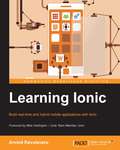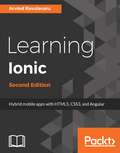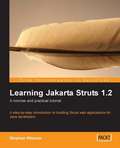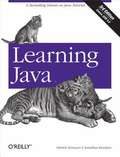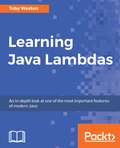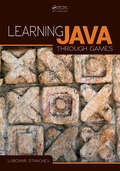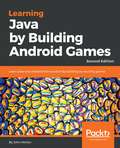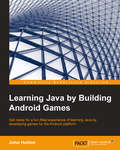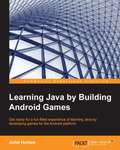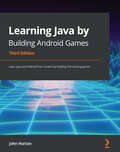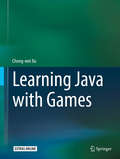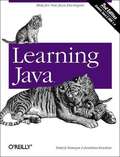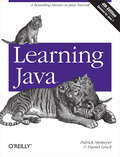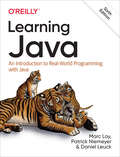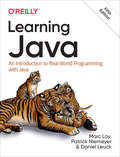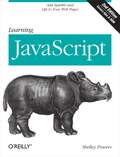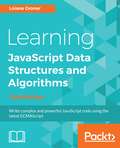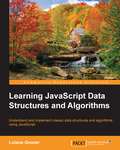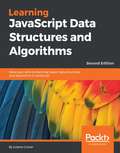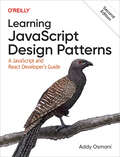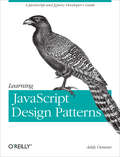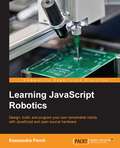- Table View
- List View
Learning Ionic
by Arvind Ravulavaru<P><P>Key Features <P><P>Create hybrid mobile applications by combining the capabilities of Ionic, Cordova, and AngularJS <P><P>Reduce the time to market your application using Ionic, that helps in rapid application development <P><P>Detailed code examples and explanations, helping you get up and running with Ionic quickly and easily <P><P>Book Description <P><P>With the growth of the start-up market, the time it takes to market your app ideas is crucial. Developing apps using each platform specific format is time consuming and will put you behind in the rat race. Enter the hybrid mobile space: using knowledge of web technologies, one can transform their ideas into complete apps in no time and distribute them to a wide market of people. <P><P>Apps developed using web technologies need to have a robust, testable, and scalable client side JavaScript framework. This is where a beautiful CSS framework named Ionic meets AngularJS to provide an elegant, robust, testable, and scalable framework enabling the building of hybrid mobile apps. <P><P>With this book, you will learn hybrid mobile application development using Ionic. This book uses Cordova 5.0.0, Ionic CLI 1.5.0 & Ionic 1.0.0 to explain the concepts and build apps. <P><P>To begin with, the book helps you understand where Ionic fits in today's world. Then you will deep dive into Ionic CSS components, Ionic-Angular directives, and services. You will also examine theming Ionic apps using the built in SCSS setup. <P><P>Next, you will learn to build an Ionic client for a secure REST API, where you will implement user authentication and token-based development. Cordova and ngCordova will be explored and you will learn how you can integrate device specific features like a camera and Bluetooth with an Ionic app. You will wrap up the book by building a messaging app, which will deal with integrating REST API as well as device features. <P><P>By the end of this book you will be able to develop a hybrid mobile application from start to finish. <P><P>What you will learn <P><P>Learn how a hybrid mobile application works <P><P>Familiarize yourself with Cordova and see how it fits into hybrid mobile application development <P><P>Seamlessly work with Ionic CSS components and Ionic-Angular <P><P>JavaScript components like directives and services <P><P>Learn how to theme Ionic apps, as well as customize components using Ionic SCSS support <P><P>Develop an app that builds a client for a Secure REST API using <P><P>Ionic & Angular <P><P>Develop a real-time chat app using Firebase, that consumes ngCordova <P><P>Learn how to generate a device specific installer for an Ionic app using Ionic CLI as well as Ionic Cloud services
Learning Ionic 2 - Second Edition
by Arvind RavulavaruThis book is for JavaScript developers with basic skills. No previous knowledge of Ionic is required for this book.
Learning Jakarta Struts 1.2: a concise and practical tutorial
by Stephan WiesnerThe book sets out to get Java developers up to speed and confident with Struts as quickly as possible. It does not explain every feature in Struts, but takes a logical path through the essential information, with the emphasis on practical applications. This book is written for Java developers planning to develop web applications, who are new to Struts. It expects familiarity with Java, JSP and Servlets to a degree, although more obscure elements are explained. It covers Struts 1.2.
Learning Java
by Jonathan Knudsen Patrick NiemeyerVersion 5.0 of the Java 2 Standard Edition SDK is the most important upgrade since Java first appeared a decade ago. With Java 5.0, you'll not only find substantial changes in the platform, but to the language itself-something that developers of Java took five years to complete. The main goal of Java 5.0 is to make it easier for you to develop safe, powerful code, but none of these improvements makes Java any easier to learn, even if you've programmed with Java for years. And that means our bestselling hands-on tutorial takes on even greater significance.Learning Java is the most widely sought introduction to the programming language that's changed the way we think about computing. Our updated third edition takes an objective, no-nonsense approach to the new features in Java 5.0, some of which are drastically different from the way things were done in any previous versions. The most essential change is the addition of "generics", a feature that allows developers to write, test, and deploy code once, and then reuse the code again and again for different data types. The beauty of generics is that more problems will be caught during development, and Learning Java will show you exactly how it's done. Java 5.0 also adds more than 1,000 new classes to the Java library. That means 1,000 new things you can do without having to program it in yourself. That's a huge change. With our book's practical examples, you'll come up to speed quickly on this and other new features such as loops and threads. The new edition also includes an introduction to Eclipse, the open source IDE that is growing in popularity. Learning Java, 3rd Edition addresses all of the important uses of Java, such as web applications, servlets, and XML that are increasingly driving enterprise applications.
Learning Java Functional Programming
by Richard M ReeseCreate robust and maintainable Java applications using the functional style of programming About This Book * Explore how you can blend object-oriented and functional programming styles in Java * Use lambda expressions to write flexible and succinct code * A tutorial that strengthens your fundamentals in functional programming techniques to enhance your applications Who This Book Is For If you are a Java developer with object-oriented experience and want to use a functional programming approach in your applications, then this book is for you. All you need to get started is familiarity with basic Java object-oriented programming concepts. What you will learn * Use lambda expressions to simplyfy code * Use function composition to achieve code fluency * Apply streams to simply implementations and achieve parallelism * Incorporate recursion to support an application's functionality * Provide more robust implementations using Optionals * Implement design patterns with less code * Refactor object-oriented code to create a functional solution * Use debugging and testing techniques specific to functional programs In Detail Functional programming is an increasingly popular technology that allows you to simplify many tasks that are often cumbersome and awkward using an object-oriented approach. It is important to understand this approach and know how and when to apply it. Functional programming requires a different mindset, but once mastered it can be very rewarding. This book simplifies the learning process as a problem is described followed by its implementation using an object-oriented approach and then a solution is provided using appropriate functional programming techniques. Writing succinct and maintainable code is facilitated by many functional programming techniques including lambda expressions and streams. In this book, you will see numerous examples of how these techniques can be applied starting with an introduction to lambda expressions. Next, you will see how they can replace older approaches and be combined to achieve surprisingly elegant solutions to problems. This is followed by the investigation of related concepts such as the Optional class and monads, which offer an additional approach to handle problems. Design patterns have been instrumental in solving common problems. You will learn how these are enhanced with functional techniques. To transition from an object-oriented approach to a functional one, it is useful to have IDE support. IDE tools to refactor, debug, and test functional programs are demonstrated through the chapters. The end of the book brings together many of these functional programming techniques to create a more comprehensive application. You will find this book a very useful resource to learn and apply functional programming techniques in Java. Style and approach In this tutorial, each chapter starts with an introduction to the terms and concepts covered in that chapter. It quickly progresses to contrast an object-oriented approach with a functional approach using numerous code examples.
Learning Java Lambdas
by Toby WestonUnderstand and utilize Java Lambdas About This Book • Take a deep dive into one of the single most important additions to modern Java • Master Java lambdas, and fully understand functions, classes, and scope. • Improve your programming skills, which will enable you to write cleaner and more dynamic code Who This Book Is For Learning Java Lambdas is for developers looking to upgrade their Java skills and familiarize themselves with one of the most important new features of Java. This book is not for absolute beginners and will be more suited to professionals who are already comfortable with Java coding. You should have a basic knowledge of Java before reading this book. What You Will Learn • What a lambda is and how it differs from other Java features • How to use lambdas effectively in your own projects • The use of method references and advanced scoping • The difference between lambdas and closures • The differences in bytecode produced when using lambdas In Detail In this short book, we take an in-depth look at lambdas in Java, and their supporting features. The book covers essential topics, such as functional interfaces and type inference, and the key differences between lambdas and closures. You will learn about the background to functional programming and lambdas, before moving on to understanding the basic syntax of lambdas and what differentiates these anonymous functions from standard anonymous classes. Lastly, you'll learn how to invoke lambdas and look at the bytecode generated. After reading this book, you'll understand lambdas in depth, their background, syntax, implementation details, and how and when to use them. You'll also have a clear knowledge of the difference between functions and classes, and why that's relevant to lambdas. This knowledge will enable you to appreciate the improvements to type inference that drive a lot of the new features in modern Java, and will increase your understanding of method references and scoping. Style and approach This book is a deep dive into one of the core new features of the Java language – Lambdas. It covers them in great details, making sure that you fully understand how lambdas work, and how they can be put to use in your own programs.
Learning Java Through Games
by Lubomir StanchevLearning Java Through Games teaches students how to use the different features of the Java language as well as how to program. Suitable for self-study or as part of a two-course introduction to programming, the book covers as much material as possible from the latest Java standard while requiring no previous programming experience. Taking an applic
Learning Java by Building Android Games: Learn Java and Android from scratch by building six exciting games, 2nd Edition
by John HortonGet ready for a fun-filled experience of learning Java by developing games for the Android platformKey FeaturesLearn Java, Android, and object-oriented programming from scratchBuild games including Sub Hunter, Retro Pong, Bullet Hell, Classic Snake, and a 2D Scrolling ShooterCreate and design your own games, such as an open-world platform gameBook DescriptionAndroid is one of the most popular mobile operating systems presently. It uses the most popular programming language, Java, as the primary language for building apps of all types. However, this book is unlike other Android books in that it doesn’t assume that you already have Java proficiency.This new and expanded second edition of Learning Java by Building Android Games shows you how to start building Android games from scratch. The difficulty level will grow steadily as you explore key Java topics, such as variables, loops, methods, object oriented programming, and design patterns, including code and examples that are written for Java 9 and Android P. At each stage, you will put what you’ve learned into practice by developing a game. You will build games such as Minesweeper, Retro Pong, Bullet Hell, and Classic Snake and Scrolling Shooter games. In the later chapters, you will create a time-trial, open-world platform game. By the end of the book, you will not only have grasped Java and Android but will also have developed six cool games for the Android platform.What you will learnSet up a game development environment in Android StudioImplement screen locking, screen rotation, pixel graphics, and play sound effectsRespond to a player’s touch, and program intelligent enemies who challenge the player in different waysLearn game development concepts, such as collision detection, animating sprite sheets, simple tracking and following, AI, parallax backgrounds, and particle explosionsAnimate objects at 60 frames per second (FPS) and manage multiple independent objects using Object-Oriented Programming (OOP)Understand the essentials of game programming, such as design patterns, object-oriented programming, Singleton, strategy, and entity-component patternsLearn how to use the Android API, including Activity lifecycle, detecting version number, SoundPool API, Paint, Canvas, and Bitmap classes Build a side-scrolling shooter and an open world 2D platformer using advanced OOP concepts and programming patternsWho this book is forLearning Java by Building Android Games is for you if you are completely new to Java, Android, or game programming and want to make Android games. This book also acts as a refresher for those who already have experience of using Java on Android or any other platform without game development experience.
Learning Java by Building Android Games
by John HortonIf you are completely new to either Java, Android, or game programming and are aiming to publish Android games, then this book is for you. This book also acts as a refresher for those who already have experience in Java on another platforms or other object-oriented languages.
Learning Java by Building Android Games
by John Horton<P><P>Key Features <P><P>Acquaint yourself with Java and object-oriented programming, from zero previous experience <P><P>Build four cool games for your phone and tablet, from retro arcade-style games to memory and education games, and gain the knowledge to design and create your own games too <P><P>Walk through the fundamentals of building games and use that experience as a springboard to study advanced game development or just have fun <P><P>Book Description <P><P>Android is the fastest growing operating system (OS) with one of the largest installed bases of any mobile OS. Android uses one of the most popular programming languages, Java, as the primary language for building apps of all types. So, you should first obtain a solid grasp of the Java language and its foundation APIs to improve the chances of succeeding as an Android app developer. <P><P>This book will show you how to get your Android development environment set up and you will soon have your first working game. The difficulty level grows steadily with the introduction of key Java topics such as loops, methods, and OOP. You'll then use them in the development of games. You will learn how to build a math test game, a Simon-like memory game, a retro pong-style game, and for the grand finale, a Snake-style, retro arcade game with real Google Play leaderboards and achievements. The book has a hands-on approach and is packed with screenshots. <P><P>What You Will Learn <P><P>Set up an efficient, professional game development environment in Android Studio <P><P>Build your very own Android UI using easy to-use tools in Android Studio <P><P>Add real-time interaction with Java threads and implement locking/handling screen rotation, pixel graphics, clicks, animation, sound FX, and many other features in your games <P><P>Explore object-oriented programming (OOP) and design scalable, reliable, and well-written Java games or apps on almost any Android device <P><P>Build and deploy a graphical pong-style game using advanced OOP concepts <P><P>Explore APIs and implement advanced features such as online leaderboards and achievements using Google game services Make your game compelling to be the next big hit on Google Play market with a content update strategy and in-game marketing
Learning Java by Building Android Games: Learn Java and Android from scratch by building five exciting games, 3rd Edition
by John HortonGet ready to learn Java the fun way by developing games for the Android platform with this new and updated third editionKey FeaturesLearn Java, Android, and object-oriented programming from scratchFind out how to build games including Sub Hunter, Retro Pong, Bullet Hell, Classic Snake, and Scrolling ShootersCreate and design your own games by learning all the concepts that a game developer must knowBook DescriptionAndroid is one of the most popular mobile operating systems today. It uses the most popular programming language, Java, as one of the primary languages for building apps of all types. Unlike most other Android books, this book doesn't assume that you have any prior knowledge of Java programming, instead helps you get started with building Android games as a beginner. This new, improved, and updated third edition of Learning Java by Building Android Games helps you to build Android games from scratch. Once you've got to grips with the fundamentals, the difficulty level increases steadily as you explore key Java topics, such as variables, loops, methods, object-oriented programming (OOP), and design patterns while working with up-to-date code and supporting examples. At each stage, you'll be able to test your understanding by implementing the concepts that you've learned to develop a game. Toward the end, you'll build games such as Sub Hunter, Retro Pong, Bullet Hell, Classic Snake, and Scrolling Shooter. By the end of this Java book, you'll not only have a solid understanding of Java and Android basics but will also have developed five cool games for the Android platform.What you will learnSet up a game development environment in Android StudioRespond to a player's touch and program intelligent enemies who can challenge the player in different waysExplore collision detection, sprite sheets animation, simple tracking and following, AI, parallax backgrounds, and particle explosionsAnimate objects at 60 FPS and manage multiple independent objects using OOPWork with design patterns such as OOP, singleton, strategy, and entity-componentWork with the Android API, the SoundPool API, Paint, Canvas, Bitmap classes, and detect version numbersWho this book is forLearning Java by Building Android Games is for anyone who is new to Java, Android, or game programming and wants to develop Android games. The book will also serve as a refresher for those who already have experience using Java on Android or any other platform but are new to game development.
Learning Java with Games
by Chong-Wei XuThis innovative approach to teaching Java language and programming uses game design development as the method to applying concepts.Instead of teaching game design using Java, projects are designed to teach Java in a problem-solving approach that is both a fun and effective. Learning Java with Games introduces the concepts of Java and coding; then uses a project to emphasize those ideas. It does not treat the object-oriented and procedure and loop parts of Java as two separate entities to be covered separately, but interweaves the two concepts so the students get a better picture of what Java is. After studying a rich set of projects, the book turns to build up a “Three-layer Structure for Games” as an architecture template and a guiding line for designing and developing video games. The proposed three-layer architecture not only merges essential Java object-oriented features but also addresses loosely coupled software architecture.
Learning Java, 2nd Edition
by Jonathan Knudsen Patrick NiemeyerThis new edition of Learning Java has been expanded and updated for Java 2 Standard Edition SDK 1.4. It comprehensively addresses important topics such as web applications, servlets, and XML that are increasingly driving enterprise applications. This edition provides full coverage of all Java 1.4 language features including assertions and exception chaining as well as new APIs such as regular expressions and NIO, the new I/O package. New Swing features and components are described along with updated coverage of the JavaBeans component architecture using the open source NetBeans IDE the latest information about Applets and the Java Plug-in for all major web browsers.
Learning Java, 3rd Edition
by Jonathan Knudsen Patrick NiemeyerVersion 5.0 of the Java 2 Standard Edition SDK is the most important upgrade since Java first appeared a decade ago. With Java 5.0, you'll not only find substantial changes in the platform, but to the language itself-something that developers of Java took five years to complete. The main goal of Java 5.0 is to make it easier for you to develop safe, powerful code, but none of these improvements makes Java any easier to learn, even if you've programmed with Java for years. And that means our bestselling hands-on tutorial takes on even greater significance. Learning Java is the most widely sought introduction to the programming language that's changed the way we think about computing. Our updated third edition takes an objective, no-nonsense approach to the new features in Java 5.0, some of which are drastically different from the way things were done in any previous versions. The most essential change is the addition of "generics", a feature that allows developers to write, test, and deploy code once, and then reuse the code again and again for different data types. The beauty of generics is that more problems will be caught during development, and Learning Java will show you exactly how it's done. Java 5.0 also adds more than 1,000 new classes to the Java library. That means 1,000 new things you can do without having to program it in yourself. That's a huge change. With our book's practical examples, you'll come up to speed quickly on this and other new features such as loops and threads. The new edition also includes an introduction to Eclipse, the open source IDE that is growing in popularity. Learning Java , 3rd Edition addresses all of the important uses of Java, such as web applications, servlets, and XML that are increasingly driving enterprise applications. The accompanying CD includes the Java 5.0 SDK for Windows, Linux and Solaris, plus the Eclipse IDE, the NetBeans IDE, and the many example programs from the book.
Learning Java: A Bestselling Hands-On Java Tutorial (Java Ser.)
by Patrick Niemeyer Daniel LeuckJava is the preferred language for many of today's leading-edge technologies--everything from smartphones and game consoles to robots, massive enterprise systems, and supercomputers. If you're new to Java, the fourth edition of this bestselling guide provides an example-driven introduction to the latest language features and APIs in Java 6 and 7. Advanced Java developers will be able to take a deep dive into areas such as concurrency and JVM enhancements. You'll learn powerful new ways to manage resources and exceptions in your applications, and quickly get up to speed on Java's new concurrency utilities, and APIs for web services and XML. You'll also find an updated tutorial on how to get started with the Eclipse IDE, and a brand-new introduction to database access in Java.
Learning Java: An Introduction to Real-World Programming with Java
by Patrick Niemeyer Marc Loy Daniel LeuckIdeal for working programmers new to Java, this best-selling book guides you through the language features and APIs of Java 21. Through fun, compelling, and realistic examples, authors Marc Loy, Patrick Niemeyer, and Dan Leuck introduce you to Java's fundamentals, including its class libraries, programming techniques, and idioms, with an eye toward building real applications. This updated sixth edition expands the content to continue covering lambdas and streams, and shows you how to use a functional paradigm in Java. You'll learn about the latest Java features introduced since the book's fifth edition, from JDK 15 through 21. You'll also take a deep dive into virtual threads (introduced as Project Loom in Java 19). This guide helps you: Learn the structure of the Java language and Java applicationsWrite, compile, and execute Java applicationsUnderstand the basics of Java threading and concurrent programmingLearn Java I/O basics, including local files and network resourcesCreate compelling interfaces with an eye toward usabilityLearn how functional features have been integrated in JavaKeep up with Java developments as new versions are released
Learning Java: An Introduction to Real-World Programming with Java (Java Ser.)
by Patrick Niemeyer Marc Loy Daniel LeuckIf you’re new to Java—or new to programming—this best-selling book will guide you through the language features and APIs of Java 11. With fun, compelling, and realistic examples, authors Marc Loy, Patrick Niemeyer, and Daniel Leuck introduce you to Java fundamentals—including its class libraries, programming techniques, and idioms—with an eye toward building real applications.You’ll learn powerful new ways to manage resources and exceptions in your applications—along with core language features included in recent Java versions.Develop with Java, using the compiler, interpreter, and other toolsExplore Java’s built-in thread facilities and concurrency packageLearn text processing and the powerful regular expressions APIWrite advanced networked or web-based applications and services
Learning JavaScript
by Shelley PowersIf you're new to JavaScript, or an experienced web developer looking to improve your skills, Learning JavaScript provides you with complete, no-nonsense coverage of this quirky yet essential language for web development. You'll learn everything from primitive data types to complex features, including JavaScript elements involved with Ajax and dynamic page effects. By the end of the book, you'll be able to work with even the most sophisticated libraries and web applications. Complete with best practices and examples of JavaScript use, this new edition shows you how to integrate the language with the browser environment, and how to practice proper coding techniques for standards-compliant websites. This book will help you: Learn the JavaScript application structure, including basic statements and control structures Identify JavaScript objects -- String, Number, Boolean, Function, and more Use browser debugging tools and troubleshooting techniques Understand event handling, form events, and JavaScript applications with forms Develop with the Browser Object Model, the Document Object Model, and custom objects you create Learn about browser cookies and more modern client-side storage techniques Get details for using XML or JSON with Ajax applications Learning JavaScript follows proven learning principles to help you absorb the concepts at an easy pace, so you'll learn how to create powerful and responsive applications in any browser.
Learning JavaScript Data Structures and Algorithms: Write complex and powerful JavaScript code using the latest ECMAScript, 3rd Edition
by Loiane GronerCreate classic data structures and algorithms such as depth-first search and breadth-first search, learn recursion, as well as create and use a heap data structure using JavaScriptKey FeaturesImplement common data structures and the associated algorithms along with the context in which they are usedMaster existing JavaScript data structures such as arrays, sets, and maps, and learn how to implement new ones such as stacks, linked lists, trees, and graphs in ES 8Develop abstract data types to make JavaScript a more flexible and powerful programming languageBook DescriptionA data structure is a particular way of organizing data in a computer to utilize resources efficiently. Data structures and algorithms are the base of every solution to any programming problem. With this book, you will learn to write complex and powerful code using the latest ES 2017 features.Learning JavaScript Data Structures and Algorithms begins by covering the basics of JavaScript and introduces you to ECMAScript 2017, before gradually moving on to the most important data structures such as arrays, queues, stacks, and linked lists. You will gain in-depth knowledge of how hash tables and set data structures function as well as how trees and hash maps can be used to search files in an HD or represent a database. This book serves as a route to take you deeper into JavaScript. You’ll also get a greater understanding of why and how graphs, one of the most complex data structures, are largely used in GPS navigation systems in social networks.Toward the end of the book, you’ll discover how all the theories presented in this book can be applied to solve real-world problems while working on your own computer networks and Facebook searches.What you will learn Declare, initialize, add, and remove items from arrays, stacks, and queues Create and use linked lists, doubly linked lists, and circular linked lists Store unique elements with hash tables, dictionaries, and sets Explore the use of binary trees and binary search trees Sort data structures using algorithms such as bubble sort, selection sort, insertion sort, merge sort, and quick sort Search elements in data structures using sequential sort and binary searchWho this book is forIf you’re a JavaScript developer who wants to dive deep into JavaScript and write complex programs using JavaScript data structures and algorithms, this book is for you.
Learning JavaScript Data Structures and Algorithms
by Loiane GronerIf you are a JavaScript developer or someone who has basic knowledge of JavaScript, and want to explore its optimum ability, this fast-paced book is definitely for you. Programming logic is the only thing you need to know to start having fun with algorithms.
Learning JavaScript Data Structures and Algorithms - Second Edition
by Loiane GronerIf you are a student of Computer Science or are at the start of your technology career and want to explore JavaScript's optimum ability, this book is for you. You need a basic knowledge of JavaScript and programming logic to start having fun with algorithms.
Learning JavaScript Data Structures and Algorithms: Write Complex And Powerful Javascript Code Using The Latest Ecmascript, 3rd Edition
by Loiane GronerA data structure is a particular way of organizing data in a computer to utilize resources efficiently. Data structures and algorithms are the base of every solution to any programming problem. With this book, you will learn to write complex and powerful code using the latest ES 8 features.
Learning JavaScript Design Patterns: A JavaScript and React Developer's Guide
by Addy OsmaniDo you want to write beautiful, structured, and maintainable JavaScript by applying modern design patterns to the language? Do you want clean, efficient, manageable code? Want to stay up-to-date with the latest best practices? If so, the updated second edition of Learning JavaScript Design Patterns is the ideal place to start. Author Addy Osmani shows you how to apply modern design patterns to JavaScript and React—including modules, mixins, observers, and mediators. You'll learn about performance and rendering patterns such as server-side rendering and Islands architecture. You'll also learn how architectural patterns like MVC, MVP, and MVVM are useful from the perspective of a modern web application developer. This book explores:Architectural patterns for structuring your components and appsMore than 20 design patterns in JavaScript and React, applicable for developers at any levelDifferent pattern categories including creational, structural, and behavioralEssential performance patterns including dynamic imports and code-splittingRendering patterns such as server-side rendering, hydration, Islands architecture, and moreAdditionally, you'll explore modern JavaScript syntax like JavaScript modules, React patterns like Hooks, higher-order components (HOCs), and more, to stay ahead in the ever-evolving world of web development.
Learning JavaScript Design Patterns: A JavaScript and jQuery Developer's Guide
by Addy OsmaniWith Learning JavaScript Design Patterns, you'll learn how to write beautiful, structured, and maintainable JavaScript by applying classical and modern design patterns to the language. If you want to keep your code efficient, more manageable, and up-to-date with the latest best practices, this book is for you. Explore many popular design patterns, including Modules, Observers, Facades, and Mediators. Learn how modern architectural patterns--such as MVC, MVP, and MVVM--are useful from the perspective of a modern web application developer. This book also walks you through modern module formats, how to namespace code effectively, and other essential topics. Learn the structure of design patterns and how they are written Understand different pattern categories, including creational, structural, and behavioral Walk through more than 20 classical and modern design patterns in JavaScript Use several options for writing modular code--including the Module pattern, Asyncronous Module Definition (AMD), and CommonJS Discover design patterns implemented in the jQuery library Learn popular design patterns for writing maintainable jQuery plug-ins "This book should be in every JavaScript developer's hands. It's the go-to book on JavaScript patterns that will be read and referenced many times in the future." --Andrée Hansson, Lead Front-End Developer, presis!
Learning JavaScript Robotics
by Kassandra PerchDesign, build, and program your own remarkable robots with JavaScript and open source hardware About This Book * Learn how to leverage Johnny-Five's Read, Eval, Print Loop, and Event API to write robot code with JavaScript * Unlock a world of exciting possibilities by hooking your JavaScript-programmed robots up to the internet and using external data and APIs * Move your project code from the Arduino Uno to a multitude of other robotics platforms Who This Book Is For If you've worked with Arduino before or are new to electronics and would like to try writing sketches in JavaScript, then this book is for you! Basic knowledge of JavaScript and Node.js will help you get the most out of this book. What You Will Learn * Familiarise yourself with Johnny-Five Read, Eval, and Print Loop (REPL) to modify and debug robotics code in real time * Build robots with basic output devices to create projects that light up, make noise, and more * Create projects with complex output devices, and employ the Johnny-Five API to simplify the use of components that require complex interfaces, such as I2C * Make use of sensors and input devices to allow your robotics projects to survey the world around them and accept input from users * Use the Sensor and Motor objects to make it much easier to move your robotics projects * Learn about the Animation API that will allow you to program complex movements using timing and key frames * Bring in other devices to your Johnny-Five projects, such as USB devices and remotes * Connect your Johnny-Five projects to external APIs and create your own Internet of Things! In Detail There has been a rapid rise in the use of JavaScript in recent times in a variety of applications, and JavaScript robotics has seen a rise in popularity too. Johnny-Five is a framework that gives NodeBots a consistent API and platform across several hardware systems. This book walks you through basic robotics projects including the physical hardware builds and the JavaScript code for them. You'll delve into the concepts of Johnny-Five and JS robotics. You'll learn about various components such as Digital GPIO pins, PWM output pins, Sensors, servos, and motors to be used with Johnny-Five along with some advanced components such as I2C, and SPI. You will learn to connect your Johnny-Five robots to internet services and other NodeBots to form networks. By the end of this book, you will have explored the benefits of the Johnny-Five framework and the many devices it unlocks. Style and approach This step-by-step guide to the Johnny-Five ecosystem is explained in a conversational style, packed with examples and tips. Each chapter also explores the Johnny-Five documentation to enable you to start exploring the API on your own.
